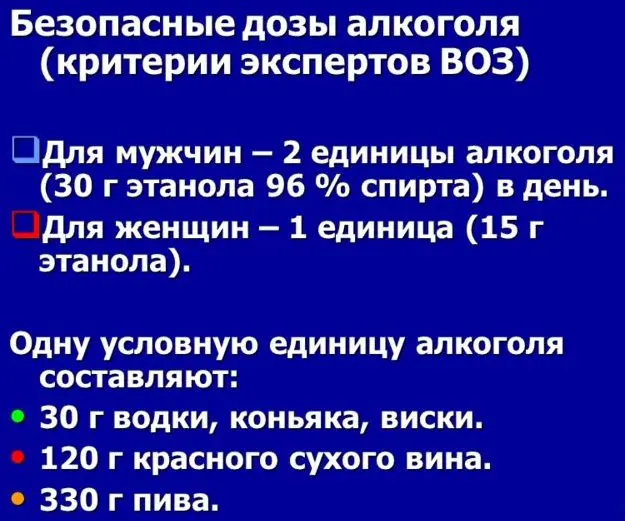The concept of a “standard alcohol unit” has been introduced by many governments and international organizations to provide advice to the public on safe amounts of alcohol. It makes no sense to publish data on mugs of beer, glasses of wine or glasses of vodka, since the strength of drinks and the volume of containers (bottles, glasses, glasses, wine glasses) differ significantly. It is much more accurate to tie alcohol consumption rates to the amount of pure ethanol.
standard unit of alcohol (Unit of alcohol, Standard drink) is the amount of pure alcohol (100% ethanol) in milliliters or grams, which is used to indicate safe portions of drinking alcoholic beverages.
There is no single “standard drink” value, since the systems for measuring volume and weight differ in different countries. For example, in the United States, 17,7 ml of ethyl alcohol is taken per unit of alcohol, in Japan – 25 ml, and in Germany and France – 12,7 ml. The main goal is to simplify the calculation to the consumer as much as possible. Many governments recommend that alcoholic beverage manufacturers list the number of standard units of alcohol on the label.
In most countries, 10 ml (8 grams) of 100% ethyl alcohol are taken for one alcohol unit. This amount on average processes the body of an adult healthy person in 60 minutes.
To calculate pure alcohol, it is enough to multiply the volume of an alcoholic beverage in milliliters by its strength as a percentage (of volume or mass), then divide by 1000. Formula:
AE = V × K ÷ 1000, where
AE – the number of units of alcohol;
V – volume (ml);
K – fortress (% volume or mass).
For example, half a liter of beer with a strength of 6% vol. contains 3 standard alcohol units (500 × 6 ÷ 1000 = 3).

Rules for drinking alcohol
The safe number of standard alcohol units for health is based on the results of medical studies, but is relevant only for healthy adults of average height and weight. The disadvantage of the method is that these already averaged values are obtained without taking into account the type of alcoholic beverage and the nature of consumption: the content of fusel oils, sugar and other substances in the composition, as well as the temperature of alcohol serving, drinking speed and the presence of snacks.
According to the National Health Service of Great Britain (NHS), the optimal daily dose of alcohol for men is 3-4 standard alcohol units (AU), for women – 2-3 AU. Each person, regardless of gender, should not exceed a daily dose of 5 AU. The recommended maximum weekly limit is 21 AU for men and 14 AU for women. Unspent units cannot be accumulated as bonuses and spent all together, as this will exceed the maximum daily allowance. It is also very important to refrain from drinking alcohol at least 3 days a week.
The difference in the amount of alcohol for men and women is due to the fact that the average woman weighs less than a man, so the female body processes alcohol more slowly per unit of time. Another important point – even with the same weight, height and age in the body of women, less alcohol dehydrogenase is produced – the main enzyme that breaks down alcohol.
Units of alcohol in popular drinks:
- 0,5 l of vodka, cognac or whiskey (40% vol.) = 20 AU;
- 0,5 l of beer (4% vol.) = 2 AU;
- 0,7 l of wine (12% vol.) = 8,4 AU;
- 0,5 liquor (18% vol.) = 9 AU.










